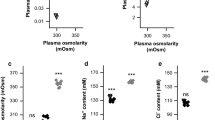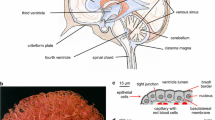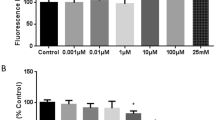Abstract.
Aquaporin-1 (AQP1) is known to be expressed at a high level in endothelial cell membranes and participates in water transfer into or across these cells. To evaluate possible effects of anesthetics on AQP1, a model assessing water permeability of erythrocytes was used, AQP1 being the exclusive water channel in red blood cells (RBC).
RBC were suspended in hypertonic (1.35%) or hypotonic (0.45%) phosphate-buffered saline (PBS). Optical density was measured continuously in an aggregometer before and during subsequent addition of hypotonic (0.45%) or hypertonic (9%) PBS, respectively. Rates of change of optical density corresponded to the rate of volume change due to osmotic effects on net water flux across the RBC membrane. We compared actions of mercuric chloride (HgCl2, definitive AQP1-blocker, 0.2 µM), and different anesthetic drugs, such as thiopental (50–200 µg/ml), phenobarbital (30–220 µg/ml), propofol (15–25 µg/ml), ketamine (3.5–11 µg/ml), midazolam (0.2–32.5 µg/ml), halothane (1.5 vol%), and isoflurane (2.3 vol%); the concentrations being in the one- to threefold range of clinically relevant plasma levels. Water transport into RBC (swelling) was inhibited by HgCl2, thiopental, phenobarbital and propofol while ketamine, midazolam, halothane, and isoflurane had no effect. Efflux of water (shrinking) was also inhibited by HgCl2, confirming a significant role of AQP1 in this model. In contrast, none of the tested anesthetic substances had any influence on water efflux. Comparison to chemically related drugs suggested oxidation of a strategic SH-group to be the mode of action.
The anesthetics thiopental, phenobarbital, and propofol significantly inhibited influx of water into RBC, while water efflux remained unaffected in distinction to HgCl2. These anesthetics thus acted as vectorial inhibitors, a hitherto undescribed phenomenon. Accordingly, some anesthetics may indeed affect transport of water via aquaporins.
Similar content being viewed by others
Author information
Authors and Affiliations
Additional information
Electronic Publication
Rights and permissions
About this article
Cite this article
Voigtlaender, J., Heindl, B. & Becker, B.F. Transmembrane water influx via aquaporin-1 is inhibited by barbiturates and propofol in red blood cells. Naunyn-Schmiedeberg's Arch Pharmacol 366, 209–217 (2002). https://doi.org/10.1007/s00210-002-0580-8
Received:
Accepted:
Issue Date:
DOI: https://doi.org/10.1007/s00210-002-0580-8




